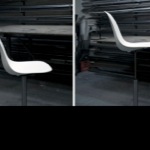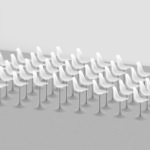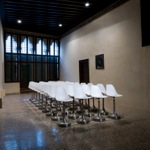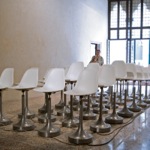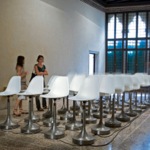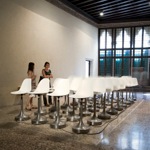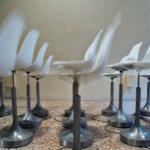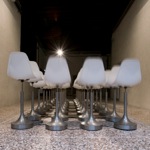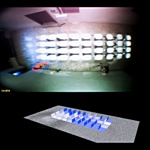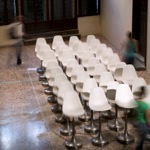Wavefunction
Subsculpture 9
“Wavefunction” (Subsculpture 9) is a kinetic sculpture comprised of fifty to one hundred Charles and Ray Eames moulded chairs (designed in 1948) and placed in a regular array of rows, facing the entrance to the exhibition space. When someone approaches the work, a computerized surveillance system detects their presence and the closest chairs automatically begin to lift off the ground, creating the crest of a wave that then spreads over the whole room. A system of electromechanical pistons raises each chair forty centimetres from the ground. The pistons are controlled by a computer that runs the mathematics of fluid dynamics, thus making the waves interfere with each other, creating turbulence or becoming calm, just like real water.
The idea of a 'function' as a field for artistic experimentation is a motivation for this piece. Other references include: the mathematics of dynamic systems, capable of generating complex non-linear, behaviours, the materialization of surveillance and turbulence and the anti-modular reinterpretation of the work of modern designers such as Charles and Ray Eames.ibition space. When someone approaches the work, a computerized surveillance system detects their presence and the closest chairs automatically begin to lift off the ground, creating the crest of a wave that then spreads over the whole room. A system of electromechanical pistons raises each chair forty centimetres from the ground. The pistons are controlled by a computer that runs the mathematics of fluid dynamics, thus making the waves interfere with each other, creating turbulence or becoming calm, just like real water.
The idea of a 'function' as a field for artistic experimentation is a motivation for this piece. Other references include: the mathematics of dynamic systems, capable of generating complex non-linear, behaviours, the materialization of surveillance and turbulence and the anti-modular reinterpretation of the work of modern designers such as Charles and Ray Eames.
The idea of a 'function' as a field for artistic experimentation is a motivation for this piece. Other references include: the mathematics of dynamic systems, capable of generating complex non-linear, behaviours, the materialization of surveillance and turbulence and the anti-modular reinterpretation of the work of modern designers such as Charles and Ray Eames.ibition space. When someone approaches the work, a computerized surveillance system detects their presence and the closest chairs automatically begin to lift off the ground, creating the crest of a wave that then spreads over the whole room. A system of electromechanical pistons raises each chair forty centimetres from the ground. The pistons are controlled by a computer that runs the mathematics of fluid dynamics, thus making the waves interfere with each other, creating turbulence or becoming calm, just like real water.
The idea of a 'function' as a field for artistic experimentation is a motivation for this piece. Other references include: the mathematics of dynamic systems, capable of generating complex non-linear, behaviours, the materialization of surveillance and turbulence and the anti-modular reinterpretation of the work of modern designers such as Charles and Ray Eames.
General info
Spanish name:
Función de Onda
Year of creation:
2007
100 chairs version
Fifty chairs version
Exhibitions
- Rafael Lozano-Hemmer: Decision Forest, Amorepacific Museum of Art, Seoul, South Korea, 2018.
- Rafael Lozano-Hemmer: Wavefunction, Subsculpture 9, University of Michigan Museum of Art, Irving Stenn, Jr. Family Gallery, Ann Arbor, Michigan, United States, 2017.
- Rafael Lozano-Hemmer, bitforms gallery, New York City, New York, United States, 2008.
- Wavefunction, Kulczyk Foundation, Poznan, Poland, 2008.
- Some Things Happen More Often Than All Of The Time (52 Biennale), Biennale di Venezia, Mexican Pavilion, Venice, Italy, 2007.
Credits
- Programming: Conroy Badger
- Simulation: Gideon May
- Production: Pierre Fournier, David Lemieux, Natalie Bouchard, Boris Dempsey, Paul Duchaine, Sandra Badger, Stephan Schulz, Olfa Driss, Guy Bärtschi, Justine Durrett
- Production Assistance: Vitra
- Commissioned for: Mexican Pavilion, 52nd Biennale di Venezia, 2007
Bibliography
- "Borusan çağdaş sanat koleksiyonu’ndan eserler UMMA’da." Artful Living, 28 Apr. 2017. Istanbul, Turkey, 2017. (türkçe) (Websites)
- "Rafael Lozano-Hemmer's kinetic sculpture featured at University of Michigan Museum of Art." Artfix Daily, 10 Apr. 2017. San Francisco, California, United States, 2017. (english) (Websites)
- "Media art from the Borusan Contemporary Art Collection featured at the University of Michigan Museum of Art." Artfix Daily, 14 Dec. 2016. San Francisco, California, United States, 2017. (english) (Websites)
- "Rafael Lozano-Hemmer PG." Prepared Guitar, 13 Jan. 2015. Madrid, Spain, 2015. (english) (Websites)
- "Sarah Greenberg picks the best of the Venice Biennale." Royal Academy of Arts Magazine Issue96, 2007. London, United Kingdom. (english) (Magazines)
- Andersson, Cecilia. "Entrevista: Rafael Lozano-Hemmer." Exit Express, Nov. 2007. Madrid, Spain, 2011. (español) (Magazines)
- Asiaghi, Anthony. "Input Output: Materialized Surveillance." Mechanical engineering, Volume 131, no.3, Mar. 2009. New York City, New York, United States. (english) (Magazines)
- Coen Cagli, Ruben. "L'invasione silenziosa." Domus, No.909, Dec. 2007. Milan, Italy. (english and italiano) (Magazines)
- Freyer, Conny, Noel, Sebastien and Rucki, Eva. "Rafael Lozano-Hemmer." Digital by design, 2008. London, United Kingdom. (english) (Books)
- Hernández, Edgar A.. "Cae en coma, curador de la bienal veneciana." Comunidad, 6 June 2007. Mexico City, México. (español) (Newspapers)
- Herrera, Adriana. "Lozano-Hemmer: conmover al mundo." Poder y Negocios, 3 June 2008. Mexico City, México, 2015. (español) (Magazines)
- Jasso, Klara. "Questions per Minute - Rafael Lozano-Hemmer." Codigo 06140, Dec. 2010. Mexico City, México, 2011. (español) (Magazines)
- Lozada, Priamo, and Bárbara Perea. "Rafael Lozano-Hemmer - 'Some things happen more often than all the time'." Kunstforum, Vol. 188, Oct. 2007. Cologne, Germany. (deutsch) (Books)
- Oh, Janet. "Closed circuits and bodies electric." ArtSlant, 19 Nov. 2015. Los Angeles, California, United States, 2016. (Websites)
 Ozog, Maciej. "Surveilling the surveillance society: the case of Rafael Lozano-Hemmer's installations." Conspiracy dwellings: Surveillance in Contemporary Art, 2010. Newcastle, United Kingdom. (english) (Books)
Ozog, Maciej. "Surveilling the surveillance society: the case of Rafael Lozano-Hemmer's installations." Conspiracy dwellings: Surveillance in Contemporary Art, 2010. Newcastle, United Kingdom. (english) (Books)- Paul, Carlos. "México vuelve a la Bienal de Venecia tras una ausencia de más de 50 años." La Jornada, 6 June 2007. Mexico City, México. (español) (Newspapers)
- Redfern, Christine. "Venetian Opera. Montreal's Rafael Lozano-Hemmer represents Mexico at the Venice Biennale." Canadian Art, vol. 24, no. 2, summer, 2007. Toronto, Ontario, Canada. (english) (Magazines)
- Royal Academy of Arts Magazine. "Venice Revisited." Royal Academy of Arts Magazine, 2007. London, United Kingdom, 2011. (english) (Magazines)
- Tolic, Ines. "Rafael Lozano-Hemmer at the 52nd international art exhibition in Venice." d'Architettura, No. 36, Aug. 2008. Milan, Italy. (english and italiano) (Magazines)
- Turner, Jonathan. "Venice ‒ The New War Zone." Tableau Fine Arts, no. 4, Sep. 2007. Amsterdam, Netherlands. (english and deutsch) (Magazines)
- Vetrocq, Marcia E.. "The Venice Biennale, all'americana." Art in America, Sep. 2007. New York City, New York, United States. (english) (Magazines)
- Young, Paul. "Watching the Detectors." Surface Magazine, 2007. San Francisco, California, United States. (english) (Magazines)
